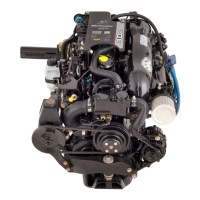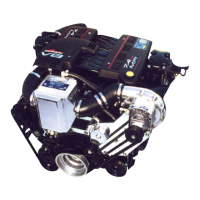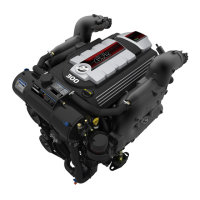EXHAUST SYSTEM SECTION - 3
Page 8 / 12 90-899883183 DECEMBER 2007
Optional Cargo Distribution
Aft storage Center storage Bow storage
25% 75% None
None 75% 25%
50% None 50%
None 100% None
100% None None
None None 100%
6. Perform the first measurement with the swim platform loaded and the person measuring the
waterline on the boat.
7. Load the swim platform if equipped.
8. Measure the exhaust elbow waterline height.
IMPORTANT: View all boat seating as rows that are parallel to the transom of the boat.
9. Load a person weight into a seat, and measure the exhaust elbow waterline height after each
person weight is loaded onto the boat. Repeat until a person weight is is loaded into each seat
in that row.
10. Continue the process moving forward toward the bow of the boat to the next row of seats until
a person weight is loaded into each seat.
EXAMPLE
NOTE: The following example is provided as a reference.
This example uses a boat that is 8.84 m (29 ft.) long and greater than 8.84 m (29 ft.) long, that
does not have a maximum rated swim platform weight capacity, and must add 226.80 Kg
(500 lb.) to the swim platform .
IMPORTANT: The Designated Seating Diagram following illustrates the number of passengers
that can sit on designated seating excluding cabin space.
Designated Seating Diagram
This example uses 9 persons as the maximum passenger load.
NOTE: Use 0.50 lb. as the break point to round up or down to obtain a whole pound.
1. To determine the maximum cargo load multiply the maximum passenger load by the maximum
cargo weight per passenger.
• 9 passengers × 25 lb. = 225 lb.
2. To determine the preferred cargo distribution for aft, center, and bow storage:
a. To determine the maximum aft storage cargo weight, multiply the maximum cargo weight
by 25%
3. To determine the maximum center storage cargo weight, multiply the maximum cargo weight
by 50%
a. 225 lb. × 50% = 112.50 lb.
b. 112.50 lb. rounded up = 113 lb.
4. To determine the maximum bow storage cargo weight, multiply the maximum cargo weight
by 25%

